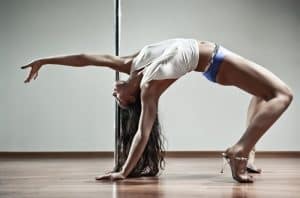Are you installing a dancing pole in your studio or home? Then you’ll have to consider your flooring, especially if you’re just renting the space. Will it damage your carpet, and will it be stable so you don’t end up crashing on the floor once it bears your full weight? If you remove the pole, how much damage can you expect, and will it cost a lot to fix it? Here are some things that you need to know about installing a pole in a carpeted room.
You can install a pole on a carpet. However, it will compress downwards from half an inch to as much as two and a half inches. Bear that in mind when you’re measuring the length from floor to ceiling, especially since you may need to retighten the pole, for added stability.
If you’re new to pole dancing and want to know what you need to know about pole dancing on the carpet, then read on.

Want to Learn and Practice Pole Dancing at Home?
I recommend opendance.academy online classes.
- Access to more than 450 high-quality video lessons with the lifetime access option ($350)
- Trial classes available from $40
- Excellent value for money when compared to the price of local pole dancing classes
- Suitable for beginner, intermediate, advanced & expert pole dancers
- Their website works on mobiles, tablets and laptops
- A stress-free training environment that you can do in your own time. No driving, parking or stress.
*Use the code dancegaily to get 10% off Pole Dancing Lessons with Open Dance Academy.
This is an exclusive offer for readers of this blog!
Will a Dancing Pole Damage the Carpet?
There are many different kinds of carpets, and while you can safely install a dancing pole on all of them, some materials will show less damage than others.
A carpet with short fibers, and designed for regular wear and tear from commercial use, is practically indent-proof. Materials like nylon (or synthetic nylon blends) are also particularly hardy. Even if you install a dance pole, use it daily and for long periods, you won’t notice any visible holes or markings. That’s because the pole won’t really sink into the material. The tight fibers can take a lot of weight without breaking. You may notice a tiny dent, but only if you’re actively looking for it—and if there is, it’s nothing that would raise a lot of attention or cause a lot of concern. You can even try those hacks to remove carpet indentations, like using a damp towel and iron, or inserting small pieces of ice in the area.
Softer carpets with longer fibers, on the other hand, will sink under the weight. Some fibers, such as olefin Berber, are also considered “non-resilient” and tend to retain indentations, even from heavy furniture or tables. Over time, the area around the pole will compact, and the longer you leave the pole there, the more permanent the damage will be. It will never regain the original bouncy, springy feel. That also holds true for any area that gets a lot of traffic—for example, where you put mats or weights, or where people tend to walk through.
Is There Any Padding Material Underneath the Carpet?
Aside from the actual carpet materials, you should consider any padding underneath. These are usually added to protect the floor or for sound-proofing. The thicker the padding, the deeper the indent will be. It’s a lot like sticking a straw through a block: a hard block won’t show much damage, but a softer and thicker Styrofoam block will always have a permanent hole.
What Kind of Carpet is Best for Pole Dancing?
If you have the ability to choose or replace the carpeting, then you have to balance different factors. Short-fibered commercial carpet fibers will show less indentation and damage, but they also are more likely to cause carpet burn. That can be an issue when you’re dancing, when many moves will have you scraping your knees and elbows on the flooring, and occasionally falling down as you learn how to use the pole. These carpets were not designed for comfort or for safety, but for durability—in fact, they’re frequently used in areas where the only thing people really do is walk. They can protect the floors, but not YOU.
Softer padded floors are more likely to have indentations from a dancing pole, and show wear and tear from frequent use. If you have a dance studio, or practice for several hours in your personal dance room, then you’ll have to prepare yourself to replace carpeting or live with a few bare spots.
However, you can choose a pole that minimizes flooring damage, and use protective gear for your elbows and knees. Dance mats or soft area rugs can also cushion your dance area.
How do I Choose Dance Poles that Won’t Damage Carpets?
If you’re very worried about damage to the floor and ceiling, and if your apartment has sheets of flimsy drywall or roofboards, then you may be better off with a portable dance pole. Since these are designed to be moved, you won’t need to worry about the permanent damage left by installing a pole, and they won’t exert as much pressure that can lead to cracks and carpet indentations. When you move, you can remove the pole and your landlord will never know that you even installed one.
Removable dance poles also won’t require screws or brackets, which is a plus if you’re worried about your apartment security deposit and aren’t really good with tools. (Note that portable dance poles won’t be as heavy-duty or as sturdy as those that are installed, so bear that in mind if you will be using it frequently.)
You also need dance pole with a good rubber base. Soft rubber won’t damage your floor, and helps cushion your weight. But here’s an important caveat: you need to invest in a quality dance pole, because cheaper knock offs will slip and slide. That can cause accidents, especially during moves when you’re spinning on the pole. And if, by good luck, you don’t end up breaking a limb or your skull, the dancing pole can slip out of place and will damage your flooring. You’re better off paying more for a good dance pole that won’t damage your carpet, then trying to get a cheap deal and spending ten times more trying to fix the dent.
Carpets vs Other Flooring: What Works Best with Dance Poles?
But if you check the dancing forums, you’ll get this very practical advice: if you have expensive hardwood floors, the smartest thing to do is to install a cheap and durable carpet. It is less likely to get indents, and if you do, you won’t feel bad about tossing it out when you move. It always ends up less expensive then replacing or repairing a high-quality wood floor.
And if you have a tile floor, carpets are your only recourse: this flooring material will inevitably crack if you try to install a dancing pole. Linoleum is less prone to damage, but is probably one of the first floors to exercise on—you’re more prone to slipping and sliding, and it offers zero protection when you fall. Carpets, even the thinnest kind, will help cushion your fall. If you invest in a thicker material and carpet padding, it can even muffle some of the sound of your dance music and foot steps. Your neighbors will thank you.
Safety First!
Always pick a sturdy, high quality dance pole and install it properly. Damage to carpets and other flooring are minimal, and any scratches or indents can be fixed. The most important thing is your safety, and your ability to enjoy dancing without having to worry about anything.
Read more:



